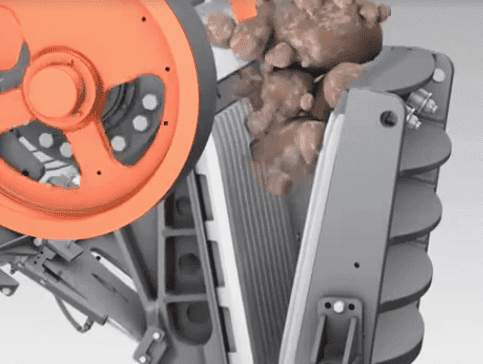
At the mining site, the sound of giant stones colliding with metal equipment is heard one after another. A device that looks like a steel beast is impacting 800 times per minute, instantly crushing limestone with a diameter of 1.5 meters into a uniform aggregate – this is the heavy-duty hammer crusher, which is indispensable to modern industry. As the core equipment of the material crushing process, its technological evolution is driving the capacity revolution in building materials, metallurgy, chemical industry and other industries.
1. Engineering breakthrough in dynamic crushing mechanism
Unlike the traditional jaw crusher which relies on extrusion crushing, the heavy hammer crusher adopts the principle of kinetic energy conversion: the motor drives the rotor to rotate at high speed, which drives the articulated hammer head to crush the material by impact. Measured data show that when the hammer head linear speed reaches 35-45m/s, the single impact energy can reach 1200-2000J, which is enough to crush all kinds of materials with Moh’s hardness below grade 7.
*The innovative design of the combined hammerhead* extends the service life to 3 times of the traditional hammerhead through the tungsten-titanium alloy inlay process. The production record of a cement group shows that when dealing with basalt raw materials, the wear of the new composite hammerhead is still controlled within 8mm after 380 hours of continuous work, which enhances the durability by 67% compared with the ordinary high manganese steel hammerhead.
2、Five core advantages of system optimization
High-efficiency crushing ratio: the three-stage crushing chamber design realizes the breakthrough of feed size ≤1200mm and discharge size ≤25mm, and the processing capacity of a single machine can reach up to 3000t/h. In granite crushing production line, it saves energy by 23% compared with the traditional equipment while the production capacity is upgraded by 40%.
Intelligent regulating system: The integrated PLC-controlled hydraulic regulating device can complete the adjustment of discharging granularity within 30 seconds. An iron ore project realized precise control of crushing size ±5mm through remote monitoring system.
Modularized Maintenance System: The split design of quick release access door and rotor disk shortens the replacement time of key components to 2 hours. This can reduce the downtime loss of about 1.2 million RMB per year in quartz sand production line.
Environmentally friendly noise reduction structure: the cooperation of multi-layer damping liner and closed casing reduces the noise of equipment operation to less than 85dB, which meets the GB12348-2008 industrial plant noise standard.
Multi-conditions adaptability: By adjusting the grate gap and hammer head arrangement, it can deal with sticky and wet materials with moisture content below 8%, which expands the application scenarios in the field of construction waste regeneration.
3、Golden combination of industry application
In the cement production line, the combination of heavy hammer crusher and vertical mill creates amazing economic benefits:
Energy consumption in the limestone pre-crushing stage is reduced by 18%
Raw mill table hourly output is increased by 25%
System power consumption is reduced from 27kWh/t to 21kWh/t
The practice of a large-scale sand and gravel aggregate project shows that after adopting a heavy-duty hammer mill as the second crushing equipment:
Needle flake content decreased from 12% to less than 5%
MB value of sand stabilized in the range of 0.8-1.2
Comprehensive maintenance cost of the equipment decreased by 30%
4. The four dimensions of scientific selection
Analysis of material characteristics: For highly abrasive materials such as basalt, the model with hammer head linear speed ≤ 38m/s should be selected and configured with stepped grate slit structure.
Capacity matching calculation: according to the formula Q=3600μδnZ/(g-tanα) (μ is the filling coefficient, δ is the density of material), accurately account for the processing capacity of the equipment.
Power system configuration: when processing the mixture with soil content >15%, it is necessary to increase the motor power reserve by 15%-20%.
Intelligent operation and maintenance requirements: For distributed mining projects, it is recommended to choose intelligent models equipped with 5G modules and predictive maintenance systems.
In the technical reform case of a large limestone mine, engineers analyzed the flow field of the crushing cavity type through three-dimensional modeling software, and finally selected PCZ1820 heavy-duty hammer breakers, which reduced the energy consumption of the system by 22%, and saved more than 2.6 million yuan of electricity costs annually. This deep integration of technology selection and production practice is redefining the efficiency standard of modern crushing process.
With the advancement of the Action Plan for Intelligent Manufacturing and Digital Transformation of the Building Materials Industry, new technologies such as intelligent sensing and digital twin are accelerating the integration with heavy crushing equipment. The latest AI visual particle size monitoring system launched by an equipment manufacturer has realized real-time feedback regulation of crushing particle size, and increased the product qualification rate to 99.3% – which signals that the industrial crushing field is moving towards a new era of intelligent sensing.